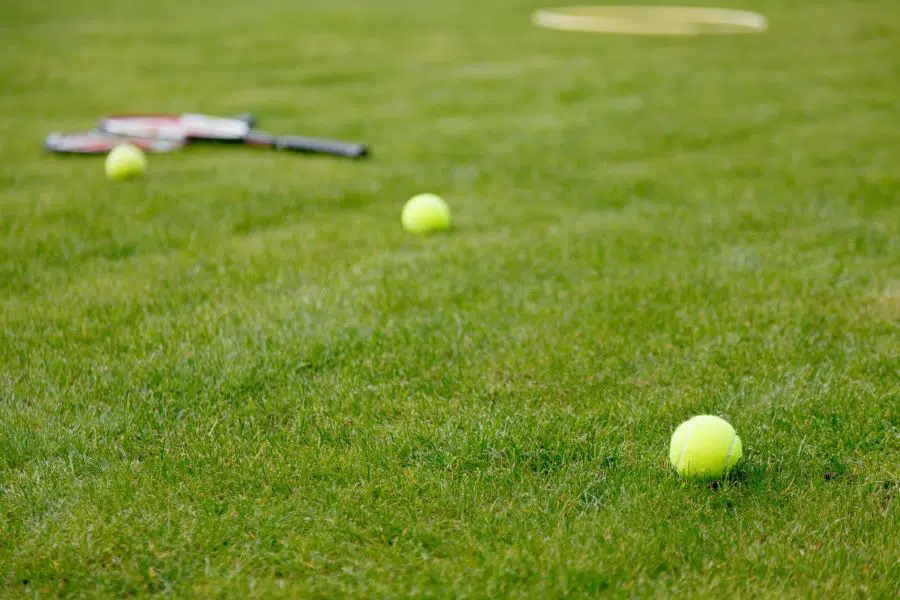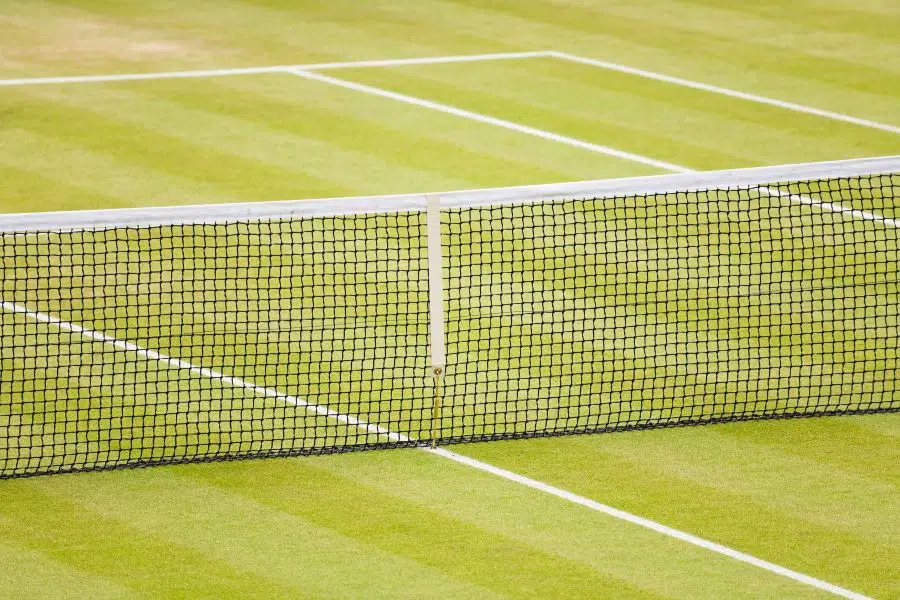Tennis can be played on a variety of surfaces, the four major types being grass, clay, hard court, and artificial grass. This offers a unique challenge to the sport’s professionals to master the technique required to adapt and be successful across all these different court surfaces.
Grass is viewed as the traditional, classic surface for tennis, the surface on which tennis was first played.
Tennis has been played on grass ever since the sport’s conception. Wimbledon is still seen by many as the most prestigious of the grand slam events, a tournament played on grass courts. Grass provides a faster surface for players, one which offers different challenges for the player.
This article will touch on the history of grass courts in tennis, and explain how this classic surface plays differently and why it remains so popular.

Lawn Tennis
By the late 1800s the indoor pastime of real tennis had moved outside, onto the lawns of Victorian high society types.
Lawn tennis descended from those walled courts of real tennis. By 1877 Wimbledon was hosting its first lawn tennis championship, primarily as a fund-raiser for the tennis club.
Across the pond, the US would stage its first national championships in 1881, again on grass.
For most participating nations, grass was the traditional tennis court surface. It has only been in fairly recent times that the major tennis tournaments have moved away from grass.
The US Open originally switched to clay in 1976, before settling on hard courts following the move to Flushing Meadows in 1978. The Australian Open was played on grass up to an even later date, only changing surface type in 1988.
The introduction of more hard courts has seen the professional grass court season reduced to a few weeks centered around Wimbledon.
At this time there are traditional grass-court tournaments played in Britain and Europe, which are used primarily as preparatory events for players ahead of the famous Grand Slam tournament in London.
How the Grass Court Game Differs
A grass surface is a living surface, bringing different challenges for players. First and foremost is the speed of the court.
A tennis ball loses less pace when it strikes a grass court, remaining 15-20% faster compared to a clay court.
While the ball skids off the grass surface at pace, the softer grass results in a lower bounce compared to other surfaces. These are nuances a player must adapt to before being able to successfully compete on grass.
The challenges do not end there, particularly for the successful player.
Unlike other surfaces, grass courts change as you go further into a tournament. The wear and tear can introduce uneven bounce, and depending on the weather conditions, may see the court speed up or slow down.
Grass courts are synonymous with short, sharp rallies, an ideal venue for serve and volley tactics. They have produced great grass-court champions such as Pete Sampras, Roger Federer, Billie Jean King, and Martina Navratilova, players whose games were perfect for the surface.
The following video offers a good explanation to why the ball behaves differently on grass courts compared to clay:
Do You Require Different Technique on Grass?
The extra pace and lower, more variable bounce of a grass court will necessitate adapting your game. If you have never played on grass before then the variable bounce, in particular, can be disconcerting.
The following are some tips that can help you adjust to grass:
- Bend your knees to put yourself in a better position to receive the lower bouncing ball
- Use lighter footwork, remaining balanced and ready to sprint or quickly change direction
- Work on your serve – a good, fast serve can put you in immediate control of a rally on grass (source)
- Use a slice backhand more, as the low bounce on grass will stop your opponent from being aggressive in their returns
- Shorten your back-swing to help you react to the lower, variable bounce
- Expect the unexpected – always be prepared in your mind for an uneven bounce
- Adjust your mentality to the faster rallies and quicker points on grass. You will need to be more aggressive in your shot making
Ultimately nothing matches experience playing on a particular surface. Grass may bring its own challenges, but they are ones to which most players can adapt to overtime.
The key point is to enjoy the experience and any opportunity to play on a grass court.
Similar to playing on clay, you will also want to ensure you have a pair of tennis shoes with good grip for a grass court (source).
Dew and moisture on grass courts can make for slippery conditions underfoot. Therefore grip is essential. Grass court shoes also tend to have less cushioning as grass is a softer, more forgiving surface.
Serve and volley was also a much more commonly used tactic on grass in years gone by.
An exponent of the serve and volley game may have looked for a shoe more aligned to a running shoe. This was to help boost their speed off the mark and for sprinting to the net so they could hit the volley at its highest point.
The Pros and Cons of Grass Courts
Besides a freshly cut grass-court just looking and feeling right, there are other benefits to playing on this type of surface. These include:
- The softer surface is better for the joints and legs.
- Shorter rallies place less stress on the arm
- Lower bounce can also place less stress on the arm, rather than consistently playing shots from a higher arc
- Consistent bounce on fresh, green grass
- Fast and spectacular game to play and spectate
Elements of a grass tennis court that can be problematic include:
- Slippery when even slightly wet
- Inconsistent bounce when court becomes worn
- Low bounce can take some getting used to
The primary disadvantage of a grass court compared to other surfaces is in its maintenance. There is a lot of work required to keep a grass court in optimal condition.
From mowing, fertilizing and top dressing the grass through to refreshing the lines, maintaining a grass court can be a labor of love.
The cost implications of this more intensive maintenance is a primary reason why grass courts are becoming rarer to find.

Finding Local Grass Courts
In an ideal world, many of us would love to have our own grass court in the garden. Not only could we play on this classic surface whenever we choose, they just look great too.
However, the world is not always ideal, and playing on a grass court requires searching one out.
The cost of maintenance is making public grass courts much rarer. Public courts tend to be hard court surfaces that provide the opportunity to potentially play all year round, generating more income for the upkeep of the facility.
Grass courts are more likely to be located at tennis clubs and privately owned businesses such as hotel complexes.
Many of these organizations will hire courts out, so the opportunity to experience a traditional grass surface is still there.
The limited number of grass courts may mean you have to book further ahead or be a little patient while you wait for one to become available.
Conclusion
You certainly can play tennis on grass and many players will say you should play tennis on grass. This most traditional tennis court surface provides fast and spectacular points.
You will need to adjust your technique if used to playing on other surfaces, but grass has ample benefits to make up for this, not least the softer surface being easier on the joints.
A well-maintained grass court can feel like playing on a lush carpet. It is an experience that should be embraced and enjoyed. You can search your local area to find tennis clubs with grass courts for hire.
Tennis is unique in how it can be played on different surfaces even at the professional level, but grass is where it all started.
